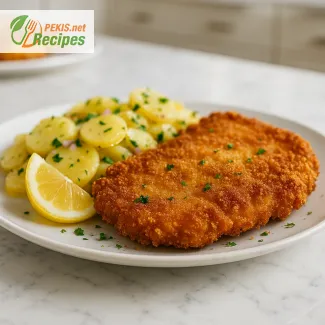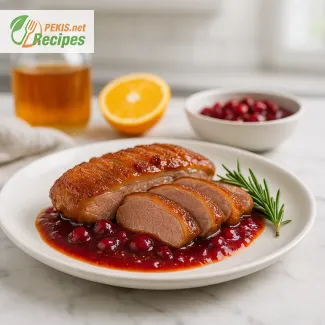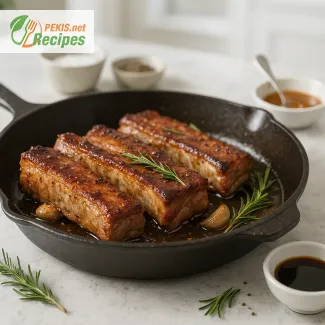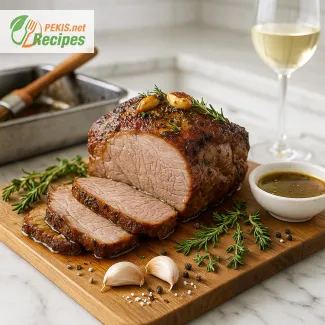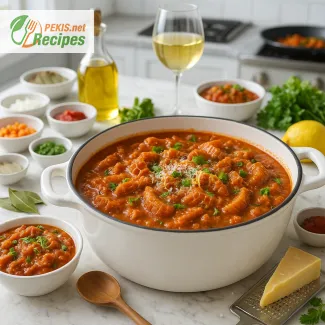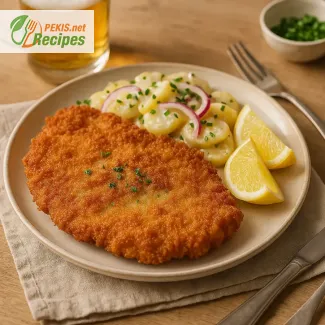
Discover the True Flavor of a Classic German Schnitzel
A crispy golden delight straight from traditional German kitchens
There's something universally comforting about a well-prepared schnitzel — the kind that's crispy on the outside, tender on the inside, and bursting with savory flavors. This dish has stood the test of time, finding its place on dinner tables across Europe and beyond. But nothing compares to the authentic German schnitzel, a culinary treasure that represents simplicity, tradition, and taste at its finest.
Originating from the heart of Central Europe, the schnitzel is often associated with Austria, but Germany has its own beloved versions that are just as rich in flavor and cultural heritage. Whether served with warm potato salad, buttery spaetzle, or a slice of lemon and a fresh green salad, a German schnitzel is more than just a meal — it's an experience. The hallmark of a great schnitzel lies in its perfectly pounded meat, light breading, and even frying to a deep golden brown that’s both pleasing to the eye and satisfying to the palate.
What makes a German schnitzel truly memorable is the balance between texture and taste. The meat — often pork or veal, though chicken is a popular modern variant — is carefully tenderized to ensure every bite melts in your mouth. It's then dredged in flour, dipped in whisked eggs, and coated with fine breadcrumbs before being shallow-fried to achieve a light, crunchy crust that seals in all the juices.
Unlike its more flamboyant international cousins, the German schnitzel doesn’t rely on sauces or heavy toppings. Instead, it celebrates the natural flavor of the meat and the delicate crunch of the breading. This approach reflects the German culinary philosophy of respecting ingredients and keeping things uncomplicated yet deeply satisfying.
This is not fast food. This is slow, mindful cooking that rewards you with every bite. Imagine slicing through that golden crust to reveal the soft, steaming center of tender meat. The scent of frying butter lingers in the air, and the sound of that gentle crunch as your fork breaks through is almost as satisfying as the taste itself.
The beauty of this recipe is in its versatility. It’s just as suited to a weeknight dinner as it is to a special celebration. Pair it with a cold German lager or a crisp white wine, and you've got yourself a meal that feels both rustic and refined. It’s the kind of dish that brings people together — whether around a family table or at a festive gathering.
And if you think making schnitzel at home is complicated, think again. With a few basic ingredients and a little care, anyone can recreate this iconic dish in their own kitchen. The process itself is as enjoyable as the result: tenderizing the meat, coating it with care, watching it sizzle and transform into a beautifully golden cutlet.
German schnitzel is more than just breaded meat — it's a dish steeped in tradition, passed down through generations, and loved by all who try it. It’s hearty without being heavy, flavorful without being fussy, and always incredibly satisfying. Whether you’re cooking for yourself, your family, or guests, this recipe brings a taste of Germany to your table with every bite.
So get ready to roll up your sleeves and bring this timeless favorite into your home. From the first crunch to the last bite, you’ll understand why schnitzel has become a cherished dish not just in Germany, but all over the world.
In the following sections, we'll guide you through every step of the process — from selecting the right cut of meat to achieving that flawless golden crust. But first, let's take a closer look at the key ingredients and the tools you'll need to master this classic at home.
- Tenderize the pork cutlets: Place each pork cutlet between two sheets of parchment paper or plastic wrap. Use a meat mallet to pound the cutlets to a thickness of about 0.5 cm (¼ inch). This ensures even cooking and a tender bite.
- Season the meat: Lightly season both sides of the cutlets with salt and black pepper. Let them rest for a few minutes to absorb the seasoning.
- Prepare the breading station: Set up three shallow bowls. Fill the first with flour, the second with beaten eggs, and the third with breadcrumbs.
- Coat the cutlets: Dredge each cutlet in flour, shaking off the excess. Dip it into the egg mixture, making sure it’s fully coated. Then press the cutlet into the breadcrumbs, ensuring an even layer. Do not press the breadcrumbs too hard — a light touch results in a fluffier crust.
- Heat the fat for frying: In a large, heavy-bottomed skillet, melt butter with oil over medium-high heat. You’ll need enough fat so the schnitzels float slightly while frying, which gives an even, golden crust.
- Fry the schnitzels: Place one or two schnitzels at a time into the hot fat. Fry each side for about 2–3 minutes or until golden brown and crispy. Use tongs to turn them gently. Don’t overcrowd the pan.
- Drain and serve: Transfer the cooked schnitzels to a plate lined with paper towels. Let them rest briefly. Serve immediately with lemon wedges, potato salad, spaetzle, or steamed vegetables.
Elevating Your Schnitzel Game: Modern Twists on a Timeless Classic
Expert tips to refine flavor, texture, and nutrition in homemade German schnitzel
Mastering a traditional dish like German schnitzel is one thing, but elevating it to new culinary heights is where the real fun begins. While the original version is beloved for its simplicity and crunch, there are numerous ways to tweak and refine the recipe to suit different tastes, dietary needs, and health preferences—without losing its signature essence. Whether you're cooking for a discerning guest or exploring new ways to enjoy this classic, these expert insights will help you turn a good schnitzel into a truly unforgettable dish.
Small ingredient upgrades that make a big difference
The foundation of a schnitzel lies in its meat, breading, and frying technique, but subtle adjustments in ingredients can significantly enhance flavor and texture.
- Meat selection matters: While pork is the standard choice, veal offers a more delicate, buttery texture that many consider the gold standard for schnitzel. For a leaner version, chicken breast or even turkey cutlets work well. Just be sure to slice and pound them thinly for even cooking.
- Breadcrumbs with character: Instead of generic store-bought breadcrumbs, try making your own using day-old sourdough, rye, or whole grain bread. These options add depth and crunch, and give your schnitzel a rustic texture that’s truly satisfying.
- Infused seasoning layers: Add grated Parmesan or a pinch of paprika to the breadcrumbs for a flavor boost. A dash of garlic powder or herbs like thyme or oregano can subtly elevate the crust without overpowering the dish.
- Use clarified butter or ghee: Traditionalists often fry schnitzel in a mix of oil and butter, but switching to clarified butter or ghee gives it a rich, nutty flavor while preventing burning at high heat. For a healthier twist, consider avocado oil for its neutral taste and high smoke point.
Why homemade schnitzel is always better
Preparing schnitzel at home allows for control over every element, ensuring a result that’s not only tastier but also tailored to your preferences.
- Customization: You choose the thickness of the meat, the seasoning level, and the type of breadcrumbs—resulting in a dish that’s entirely your own.
- Quality ingredients: At home, you can use fresh, non-processed meat, organic eggs, and chemical-free breadcrumbs. This not only improves the flavor but makes the meal healthier and more wholesome.
- Freshness and texture: A freshly breaded schnitzel, fried and served immediately, has a superior crunch and flavor that frozen or pre-prepared versions simply can’t match.
Avoiding the most common schnitzel mistakes
Even seasoned cooks can make errors that prevent a schnitzel from achieving its full potential. Here are the pitfalls to avoid:
- Skipping the meat pounding step: A schnitzel that’s too thick will cook unevenly and lack tenderness. Always pound the meat to about 0.5 cm (¼ inch).
- Overcrowding the pan: This leads to uneven browning and soggy crusts. Cook one or two schnitzels at a time to maintain proper oil temperature.
- Pressing the breadcrumbs into the meat: Lightly coat instead of pressing the breadcrumbs in. This ensures a fluffy, crispy texture.
- Using cold meat: Room temperature cutlets fry more evenly. Let the meat rest for 15–20 minutes before breading and frying.
- Reusing oil: Always use fresh oil or clarified butter for each batch to maintain clean flavor and proper crisping.
Healthier twists for guilt-free indulgence
While schnitzel isn’t typically known as a diet food, small changes can make it significantly healthier without compromising taste.
- Go baked instead of fried: Coat your schnitzel as usual, then spray it lightly with oil and bake at 200°C (400°F) for 20 minutes, flipping once. The result is a lighter crust with fewer calories.
- Try an air-fryer: An air-fried schnitzel achieves similar crispness with a fraction of the oil. Preheat the air fryer to 200°C (400°F) and cook for 8–10 minutes per side.
- Use whole grain coating: Substitute regular breadcrumbs with whole grain panko or crushed oats for added fiber and nutrients.
- Lean protein choices: Use chicken or turkey instead of pork to reduce fat content while keeping the dish protein-rich.
Pairings and plating enhancements
Sometimes, what accompanies the schnitzel can elevate the dish just as much as the schnitzel itself.
- Citrus twist: Don’t just serve lemon wedges—try a light lemon-herb butter drizzle for a touch of brightness.
- Pickled vegetables: A side of pickled red onions, gherkins, or beetroot adds acidity and balances the richness of the fried meat.
- Modern sauces: While purists may prefer schnitzel plain, a light mustard sauce or herb yogurt dip can bring freshness and variety to the plate.
- Fresh greens: Pair with arugula salad, light vinaigrette, or even a German cucumber salad (Gurkensalat) to add a crisp, refreshing note.
Reimagining tradition while honoring its roots
The beauty of the schnitzel lies in its balance of simplicity and flavor. You don’t need to stray far from the original recipe to enhance it—sometimes, the smallest tweaks bring the biggest rewards. Whether it’s a more flavorful crumb, a healthier preparation method, or a perfectly chosen side dish, every detail counts.
Cooking is a journey, and recipes like schnitzel give us the perfect canvas to explore, refine, and rediscover. In your own kitchen, you have the power to create a version of this classic that is not only faithful to tradition but also uniquely your own.
- Gluten (from flour and breadcrumbs)
- Eggs
Gluten-free and allergen substitution tips:
- Replace wheat flour and breadcrumbs with certified gluten-free alternatives. Use crushed gluten-free cornflakes or almond meal for the crust.
- Substitute eggs with a mixture of plant-based milk (60 ml / ¼ cup) and 1 tbsp cornstarch for binding.
- Vitamin B12: 1.4 µg – Supports nerve function and red blood cell production
- Vitamin B6: 0.8 mg – Aids in metabolism and immune response
- Iron: 2.2 mg – Essential for oxygen transport in the blood
- Zinc: 3.5 mg – Supports immune system and wound healing
- Selenium: 32 µg – Powerful antioxidant, supports thyroid function
- Magnesium: 35 mg – Important for muscle and nerve function
- Potassium: 420 mg – Regulates fluid balance and muscle contractions
- Phosphorus: 280 mg – Maintains healthy bones and teeth
- Selenium: 32 µg – Reduces oxidative stress, supports immune response
- Vitamin E (from oil): 1.8 mg – Protects cells from damage
- Carotenoids (trace amounts from egg yolk): ~60 µg – Supports eye health and immunity
